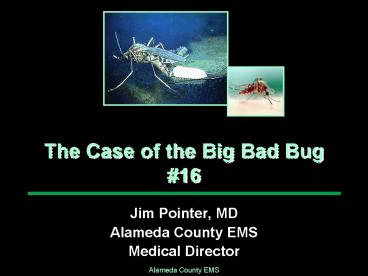The Case of the Big Bad Bug - PowerPoint PPT Presentation
1 / 28
Title:
The Case of the Big Bad Bug
Description:
A south county resident calls 9-1-1 complaining of a 2 day history of fever (103 ... Corrids (crows, ravens, jays) are particularly susceptible ' ... – PowerPoint PPT presentation
Number of Views:49
Avg rating:3.0/5.0
Title: The Case of the Big Bad Bug
1
The Case of the Big Bad Bug16
- Jim Pointer, MD
- Alameda County EMS
- Medical Director
2
The Call
- A south county resident calls 9-1-1 complaining
of a 2 day history of fever (103), headache,
maliaise, nausea, weakness, stiff neck, and a
rash.
3
History
- The patient is a 74 year old male with a past
history of CABG x 3 and prostate cancer. - Current medications include
- Nitroglycerine
- Aspirin
- Proscar
- No history of foreign travel
4
Field Assessment
- Primary survey WNL
- Vital signs
- B/P 152/97, PR 138, RR 22
- Temp 102.6 p.o.
- Secondary survey (pertinent findings)
- HEENT dry mucous membranes
- Lungs clear
- Skin warm/dry erythematous maculopapular rash
on neck trunk - Neuro confused, GCS 13 - 14
5
Treatment
- IV normal saline 500ccs
- Glucose check 102 mg/dl
- Transport to Culex Memorial Hospital
6
Hospital Course
- The patient tells the physician that he saw
several dead Stellars Jays on his property 5-7
days ago. When he picked them up he received
several insect bites
7
Hospital Exam
- Vital signs
- B/P 142/98, PR 126, RR 20
- Temp - 102.7 p.o.
- Pulse Ox - 98 RA
- Additional physical findings
- Mild nuchal rigidity
8
Laboratory Findings
- CBC 11.1 K
- 86 lymphocytes, 10 PMNs, 2
Basophils, 2 Eosinophils - Na, K, HCO3, Cl-, BUN, creatinine, glucose
WNL - Cerebrospinal fluid
- Color clear, WBC 120 cells/mm3
- Protein 82 mg/dL (n 20 45)
- Glucose 78 mg/dL (n 50 80)
9
(No Transcript)
10
West Nile Virus
- Ecology
- Enzootic cycle culcine mosquitoes and birds
- Corrids (crows, ravens, jays) are particularly
susceptible - Bridge vector mosquitoes in late summer
- Over 30 mosquito species responsible
- Mammals (humans, horses, ? deer)
dead-end hosts - Surveillance systems dead birds,
sentinel chickens, ill horses
11
West Nile Virus (cont.)
- First isolated in 1937
- First occurred in western hemisphere in New York
in 1999 - About 400 deaths reported in the US to date
about 9,000 cases reported for 2003 - Vaccine available for horses (1/3 of infected
horses die)
12
Transmission Cycle
13
Virology
- Single stranded RNA virus
- Family Flaviviridae
- Genus Flavivirus
- Member of Japanese encephalitis virus
serocomplex including - Japanese encephalitis
- St. Louis encephalitis
- Murray Valley encephalitis
- Kunjin viris
14
Geographic Distribution 2004
15
Geographic Distribution Calif.
16
Geographic Distribution horses
17
Clinical Features
- Incubation period 3 14 days
- Probably lt 20 of those infected will develop
clinical infection - Febrille illness of sudden onset
- malaise, myalgias, anorexia
- nausea, vomiting
- Eye pain, headache
- Rash, lymphadenopathy
18
Clinical Features (cont.)
- 1/150 infections result in meningitis/
encephalitis - Encephalitis is more common
- Advancing age most significant risk factor for
neurologic disease - Age 50 to 59 - 10x higher
- Age gt 80 - 43x higher
- Severe weakness in 50 of hospitalized patients
in U.S.
19
Table of Symptoms
20
Outcome
- Death rates 4 14
- Much higher in older patients or those with
diabetes or immunocompromised - Morbidity
- Fatigue
- Memory loss
- Depression
- Difficulty walking
21
Treatment
- Supportive
- Ribavirin and interferon effective in vitro
- No clinical trials
22
Lab Findings
- WBC normal or elevated
- Occasional anemia
- Low sodium
- CSF
- WBC - 0 to 1782 cells/mm3
- Protein - elevated
- Glucose - normal
23
Lab Findings (cont.)
- MRI meningeal or periventricular enhancement
- IgM
- most efficient diagnostic method (serum
or CSF) - Persistent for gt 6 months
- Present in other Flavivirus infections and
in vaccinated persons
24
Reporting
- Reportable disease
- Serum and CSF specimens must be submitted
25
Prevention
- Reduce of mosquitoes
- Eliminate breeding sites
- Apply larvacides or approved pesticides
- Prevent mosquito bites
- Use DEET (not gt 50 adults/10 kids)
- Employ barrier methods
26
(No Transcript)
27
Pull out Bettypull out! I think you hit an
artery
28
Reference
- Petersen LR, Marfin AA West Nile Virus A primer
for the clinician, American Journal of Internal
Medicine. 2002 137 E 173 - 179































